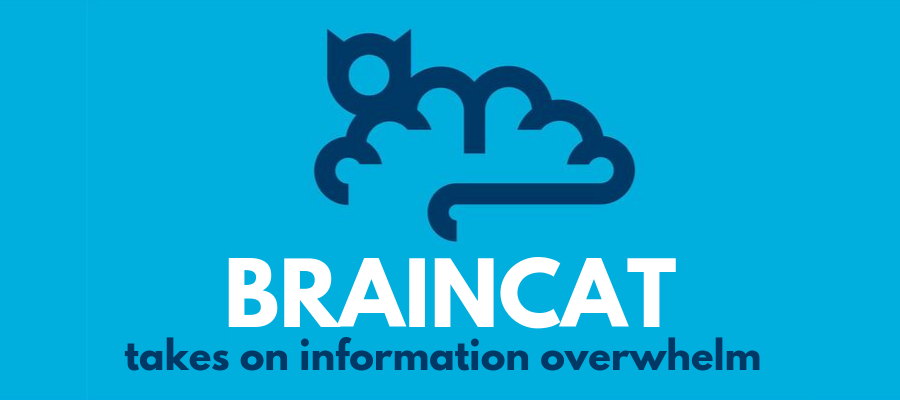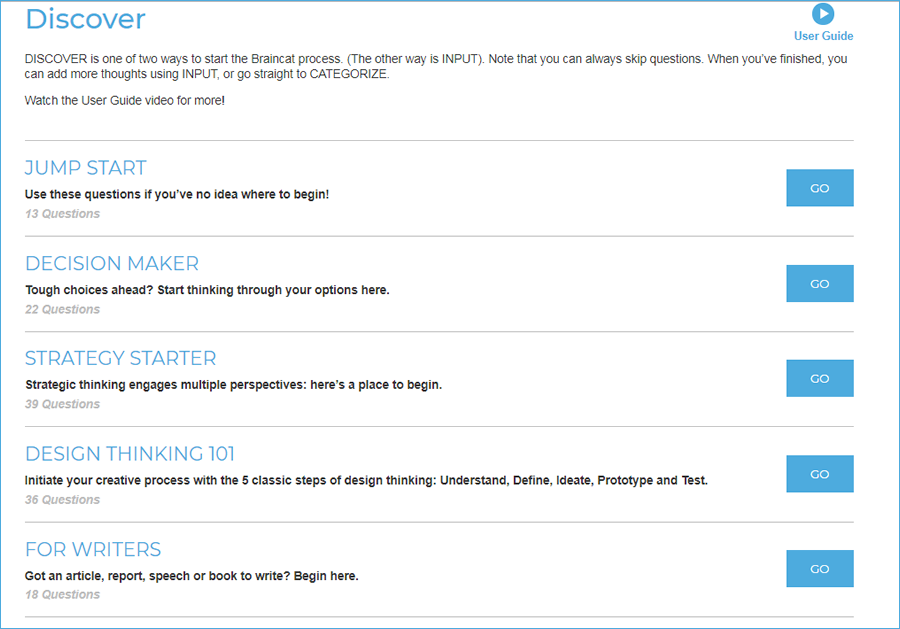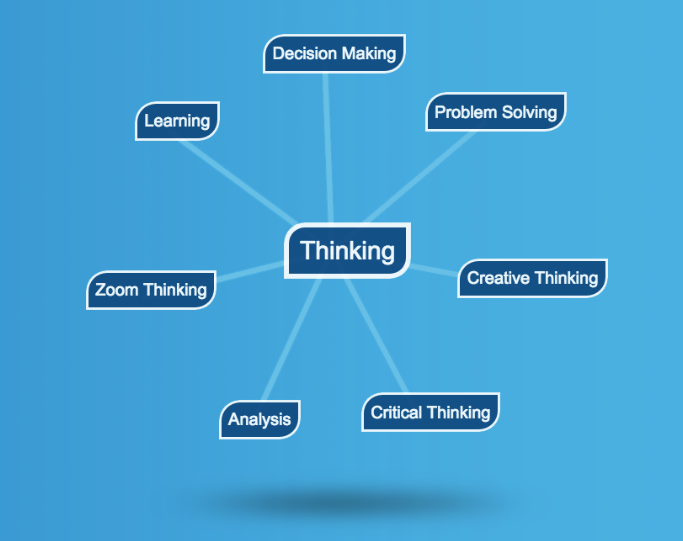
Are you a victim of information overwhelm? It has very real consequences for your brain: It increases stress and makes it almost impossible for you to think creatively and productively. That’s why Jon Ward created Braincat, a web-based thinking tool that can help you absorb, organize and make sense out of the deluge of knowledge, data and information that’s coming at you.
I recently had an opportunity to take an early look at Braincat and to ask him about the thinking behind this intriguing toolkit, which includes an exercise called “reverse mind mapping.”
Chuck Frey: What is your professional background?
Jon Ward: I’m a writer first of all. As a teacher, I published a high-school textbook on writing decades ago, and I stumbled into copywriting by chance. That led me to co-owning an ad agency, and then to consulting on branding and marketing. Today, I serve as director of marketing for a groundbreaking nutraceutical company. I’m also an adjunct advisor to the leading consultancy in the direct selling industry. I’ve been collaborating for two years on a major book about creating change by one of the world’s top designers. And I’m consumed with the launch of Braincat®. So I keep quite busy!
Frey: What are some of the common thinking challenges you’ve seen over the years that knowledge workers tend to struggle with?
Ward: TMI – too much information. The total volume of knowledge in the world is doubling every year. We’re constantly bombarded with data, opinions, messages, and every kind of mental and emotional stimulus. That’s the challenge: how to hear your own signal amidst all this noise. Where to find clarity in chaos.
Frey: How did that lead you to create Braincat? What was the thinking process behind it?
Ward: As a consultant, I’m used to being fire-hosed with random information. Clients will unload their whole story, just as it comes to them: a mishmash of information — industry, product, marketing, finance, and personal issues. My job has been to absorb all this stuff, and come back quickly with useful insights. So I developed a process to do that. The Braincat process came before the software. The process is about reducing information without short-cuts. Simplifying, not dummifying.
Frey: How does Braincat solve those challenges?
Ward: The Braincat process welcomes a mass of unsorted mental stuff, and reduces it to key ideas so you can think clearly.
Frey: There is a school of thought among creativity experts that says that deconstructing a problem or challenge is the key to solving it. Is Braincat based upon this philosophy?
Ward: It’s more than a philosophy. It’s basic neuroscience. The human brain has a bottleneck, called the working memory. This is the part of the brain (actually a network of parts) that we use to do our conscious thinking. No matter how smart you are, your working memory can only hold a maximum of seven things in mind at the same time. If you overload the working memory, you get stressed. You down-shift to lower brain functions. You lose your mental mojo. The only way to sustain creativity is to reduce the load on your working memory. So you have to condense the problems you’re trying to solve.
Frey: How do creative questions help people to focus their thinking and generate new insights?
Ward: I don’t believe anyone knows. I’ve searched the cognitive science on this, without finding a satisfactory explanation. Questions have an uncanny power. For whatever reason, when you throw the brain a question, it will go searching for an answer. It’s like throwing a stick for a dog. The response is immediate and irresistible. Your mind is pulled into focus, and it starts producing new perceptions. That’s why the Braincat process begins with questions.
Frey: How does categorization help people to focus their thinking and generate new insights?
Ward: The human brain is a pattern-seeking device. We look for similarities between things and form categories. That’s how we produced the miracle of language. There are billions of feathery creatures flying about in the sky, and we have one category, “bird”. Categories reduce the information overload so that our poor working memories can handle it. The Braincat process leverages this natural power of the mind, through the intentional use of categorization. You keep asking yourself: “What kind of thing is this?” And that way, you turn a mass of stuff into a few powerful categories.
Frey: How does the way in which the subconscious mind works align with the idea of categorization?
Ward: That’s a beautiful question. The deliberate process of categorizing teaches the subconscious how to see the information in front of it. When you use Braincat, you don’t just enter categories into the software, you enter them into your brain. As a result, you reach a point where you can push the software aside. You’ve primed the subconscious, and it’s ready to take over. You can get to work thinking or writing or planning without looking back.
Frey: Why is it important not to commingle entering your ideas into Braincat and categorizing them?
Ward: Disorder comes before order. And the ability to tolerate disorder is one of the keys to creativity. You have to allow a stage of unclarity before you get to clarity. If you organize too quickly — for example when you’re entering the raw data — you’ll short-circuit the process and decapacitate the mind.
Frey: What advantages does your form-based approach have over developing and capturing your ideas directly in a visual format, such as a mind map?
Ward: Precisely that you can pour everything in just as it comes. You’re not struggling to give shape to it: you allow it to be as random as it is, to begin with. That’s not to devalue visual formatting. There’s a simple mind map in Braincat, but it comes later. We’ve found that allowing an initial stage of disorder can be invaluable, especially when you’re facing a large volume of ideas and information. It’s like Marie Kondo when she’s decluttering a house. She creates a moment of reverence for the existing situation. Then she says: “Let’s tip all your clothes onto the bed.”
Reverse mind mapping
Frey: What is reverse mind mapping and where is it useful?
Ward: Let me contrast it with traditional mind mapping. Your classic mind map begins with a blank space and a single idea in the center which you then expand to add more and more detail. Reverse mind mapping begins with a mental space that’s already filled with unsorted detail. So it solves a quite different problem. If you have nothing to begin with, and you want to generate new material, traditional mind mapping can be a great tool. But if you already have more material than you know what to do with, reverse mind mapping is the process for you.
Frey: How does reverse mind mapping work?
Ward: Reverse mind mapping travels in the opposite direction to mind mapping. It moves from complex to simple, instead of from simple to complex. Most importantly, it discovers the categories hidden in the detail, rather than setting up categories and then filling them in. That’s a critical difference. The process of mental discovery brings a special clarity. It’s like peering into a fog and seeing the outline of someone you know.
Frey: How does reverse mind mapping overcome the shortcomings of traditional mind mapping?
Ward: It’s all about the starting point. With traditional mind mapping, you begin with a single concept and build around it. Let’s call that “the big idea.” But suppose you don’t know what the big idea is? When I’m developing a brand for a client, I certainly don’t know: that’s what they’re paying me to figure out! With reverse mind mapping, the big idea is the prize at the end of the process.
Frey: Who is Braincat ideally suited for?
Ward: We’re still finding out! We’re a young company, so there’s a lot we have to learn about our target market. I can tell you that people have used Braincat to write sermons, plan real estate rehabs, manage institutional projects, prepare college papers, and process their emotions. Go figure! We’re clearly working far upstream, supporting the very basics of thinking. So it’s going to take time to see where this plays best.
Frey: What types of projects are best suited to use with Braincat?
Ward: One definite answer: writing. Speaking personally, I never write anything without using Braincat. It’s so reassuring to know you can pour in all your ideas, just as they come, and then generate a ready-to-use outline. After you’ve done it a few times, the Braincat process is really fast.
Frey: What’s next for Braincat?
Ward: I’m just back from three months in Europe, and I’m keen to get into lots of one-on-one conversations with our users. There’s a tremendous amount to learn about how people are applying Braincat, and what enhancements they’d like us to build. We’re just beginning. Braincat will grow to meet the needs of its users. They will be our teachers.
Frey: Where can readers of this blog learn more about Braincat?
Ward: There are three little videos on our website, thebraincat.com, and they pretty much tell the whole story. But the best way to learn about Braincat is to use it. You can try it for two weeks for $1, and we’ve made cancellation easy. The key is to jump in and start the process. You’ll know soon enough if it’s going to be helpful. Apart from that, I’ll be happy to respond to your reader’s questions by email: jon.ward@thebraincat.com. Just be patient about a reply as I have my own battles with TMI, like everyone else!



Leave a Reply